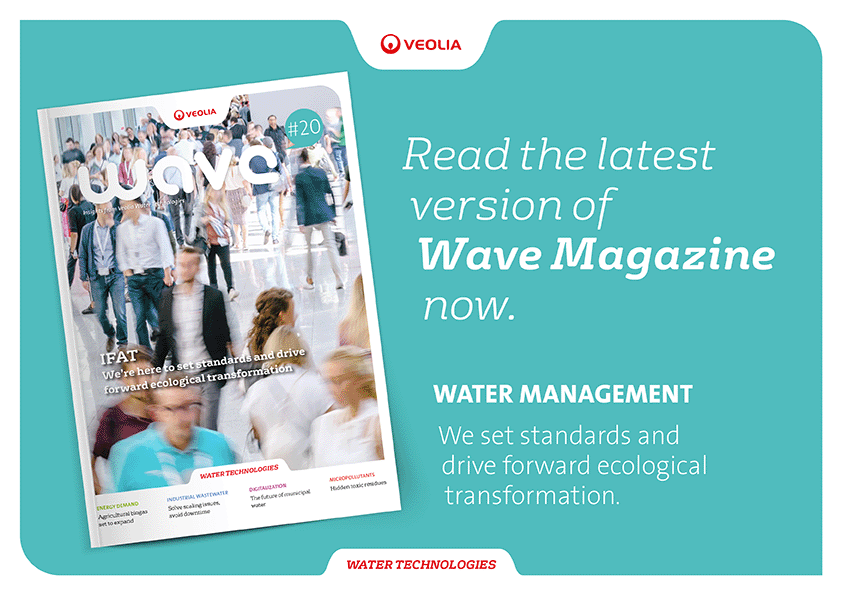Specifically designed to meet the needs of small to medium-sized hotels, construction sites and municipal communities in remote areas, Ecosim™ provides biological treatment for domestic wastewater, within a range of 50 to 2,000 population equivalents (PE).
Easily integrated into an existing wastewater treatment system, Ecosim is PMT’s — a subsidiary of Veolia Water Technologies — newest wastewater treatment system featuring a patented hybrid technology between a rotating biological contactor (RBC) and Moving Bed Biofilm Reactor (MBBR).
Compared to its older cousin, Ecodisk™, Ecosim is up to 300 percent more compact while offering the same plug-and-play biological treatment capabilities. Now, Munir Ali Turan, Process and Sales Engineer from PMT, tells us what we need to know about this new technology on the block.

What are the new trends in domestic wastewater treatment?
There are three important movements in the domestic wastewater market. The first is localization whereby multiple small to medium-sized decentralized wastewater treatment plants (WWTPs) are installed, instead of one or two large ones. This facilitates an on-source treatment approach while avoiding the relative costs and risks associated with extensive sewage lines as well as simplifying maintenance and operations. Another important aspect is energy autonomy for two key reasons. Firstly, to reduce the carbon footprint of the operations but also to improve resiliency in areas where electrical grids face instabilities. Fully solar-powered and hybrid solutions are gaining a lot of attention. The third focus is reuse. Today many of our customers require reuse as a standard on their treated wastewater. This helps bridge the gap between supply and demand, especially in the Middle-East and Africa region where there is already a potable water shortage.
What are the big challenges customers are facing and how are they tackling these obstacles?
“Staffing and resiliency are certainly the biggest obstacles we help our customers workaround. Many of our customers are not able to have trained engineers on-site around the clock due to the fact operations are relatively small and often remote. To counteract this, the technology being counted on needs to be robust, and reliable and also require low maintenance during the operation phase. Then, in terms of resilience, as mentioned earlier, many of our customers are completely off-grid or can encounter large interruptions in their electricity feed so their solutions need to be completely — or at least semi — autonomous."
Ecosim combines Ecodisk and AnoxKaldnes® MBBR technologies, so what are the defining principles?
“Ecodisk is an attached growth process where the development of the biology takes place on the disc surface. The key advantage is that Ecodisk has only a single gear-motor in order to maintain the mechanical aeration of the system resulting in extremely low OPEX, compared to the competing blower-based technologies.
AnoxKaldnes™ MBBR is a moving bed biofilm reactor technology that is also an attached growth treatment process but the development of the biology takes place on the dedicated media surface. Due to its design and unique 3D structure, the projected surface area for bacterial activity is much larger than competing technologies. This provides a highly compact solution which ensures an important advantage in the wastewater treatment market.
Now for Ecosim. This newly developed combo-solution includes both advantages: it has a drum filled with the 3D MBBR media, which provides a high projected surface within a low footprint; and it only has one gear-motor, which provides adequate aeration for biological activity with low OPEX.”
What are the main benefits Ecosim ensures to customers?
“Ecosim provides a high surface area for bacterial development within a small footprint and there are several benefits thanks to this: firstly, the compactness. Compactness means faster manufacturing time as well as easier and cheaper transportation. In addition, it can be implemented rapidly on-site.
Secondly, it has lower power requirements and therefore reduced electrical consumption meaning it requires less OPEX; and still, the one gear-motor provides the adequate oxygen transfer to the biofilm.”
How should customers choose between Ecosim and Ecodisc?
“Both technologies come from the same process family and both can be customized to meet specific requirements by our technical department so it really depends on each customer’s needs. The key thing to remember is that Ecosim is more compact with a higher projected surface area but within a restricted footprint. Whereas, Ecodisk has a smaller surface area for the same footprint and it can feature up to five biological tanks within the same module, which means that it can provide a higher retention time than Ecosim.”
Continual improvements in wastewater treatments are necessary as discharge requirements become stricter. What part does Ecosim play?
“As discharge standards become stricter and as the global population increases, existing WWTPs will start to suffer from the excess charge coming to the plant. Thanks to its modular, plug-and-play approach, Ecosim can propose a rapid upgrade of existing infrastructure by reinforcing the existing treatment process, either as a tertiary step or by proposing an additional parallel line to take on extra flow.
For example, let’s look at a lagoon treatment or extended aeration which is functioning for carbon and ammonium (NH4) removal. Owing to population increases, the excess carbon loading starts to reduce NH4 removal performance. In this case, Ecosim can be introduced downstream to provide an extra surface area for nitrifiers and hence take the excess load on the existing lagoon.”

In terms of increasing environmental restrictions, what are your predictions and how can wastewater managers prepare?
“For sure we will face an increased obligation to reuse water owing to the mounting water stress and the impacts of climate change on a global scale. It’s a matter of when not if. Another reason for the increase in reuse is the need to limit unused discharge. By reusing treated wastewater, clients not only create extra value by using the resource for other needs but they become more self-sufficient, efficient and sustainable.”



